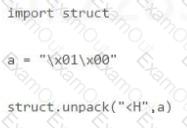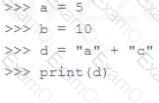Which command produced the following output?

With a requests session object named "browser", how can the expiration attribute of a cookie named "MUID" from "gpyc.com/" be accessed?
Review the following code.

What is the output?
During a password guessing attack, which HTTP request method would a Python program most commonly call to submit a usemame and password to a target website?
What does the "enumerate" function return when applied to a list?
What is the output when the following commands are typed in Python interactive mode?

What is the output of the following line of code typed into a Python interactive session?

What would be the string resulting from the following command, considering the string variable "gpyc"?


Which of the following would produce this list?
[65, 66, 67, 68]
What does the LIMIT function restrict in an SQL SELECT statement?

